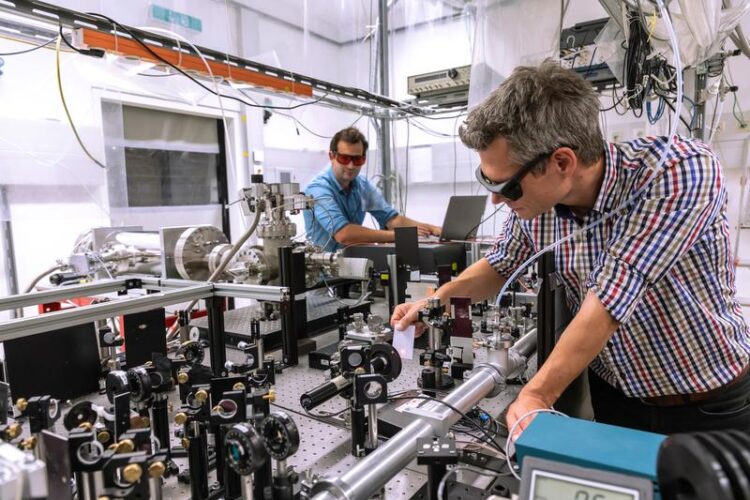Electrons in quantum liquid gain energy from laser pulses

Leonhard Treiber (left) and Markus Koch demonstrated for the first time that laser-assisted electron scattering can also be observed in condensed matter.
www.lunghammer.at / © Lunghammer – TU Graz
The absorption of energy from laser light by free electrons in a liquid has been demonstrated for the first time. Until now, this process was observed only in the gas phase. The findings, led by Graz University of Technology, open new doors for ultra-fast electron microscopy.
The investigation and development of materials crucially depends on the ability to observe smallest objects at fastest time scales. The necessary spatial resolution for investigations in the (sub-)atomic range can be achieved with electron microscopy. For the most rapid processes, however, proceeding within a few femtoseconds (quadrillionths of a second), the time resolution of conventional electron microscopes is insufficient. To improve the time duration of electron pulses, electrons would have to be selected within a shorter time window – in analogy to a camera shutter, which controls the exposure time in photography.
In principle, this temporal selection is possible with extremely short laser pulses through a process called laser-assisted electron scattering (LAES). In this process, electrons can absorb energy from the light field during collisions with atoms of the sample under investigation.
“Structural information is provided by all electrons, but those that have a higher energy level can be assigned to the time window in which the light pulse was present. With this method, it is possible to select a short time window from the long electron pulse and thus improve the time resolution,” explains Markus Koch, professor at the Institute of Experimental Physics at Graz University of Technology. So far, however, LAES processes have only been observed in the gas phase, despite their investigation for about 50 years.
Markus Koch and his team, in collaboration with researchers from Photonics Institute at Vienna University of Technology and the Institute of Chemistry at Tokyo Metropolitan University, have now demonstrated for the first time that laser-assisted electron scattering can also be observed in condensed matter, specifically in superfluid helium.
Superfluid helium leading to success
The TU Graz researchers performed the experiment in a superfluid helium droplet of few nanometer diameter (3-30 nm), into which they loaded single atoms (indium or xenon) or molecules (acetone) that served as an electron source – a field of expertise at the institute. “The free electrons can move almost without friction within the droplet and absorb more energy in the light field than they lose in collisions with the helium atoms,” says Leonhard Treiber, the PhD student in charge of the experiment. The resulting acceleration allows for the observation of much faster electrons.
The experiments could be interpreted in cooperation with Markus Kitzler-Zeiler, an expert for strong-field processes at TU Wien, and the LAES process was confirmed through simulations by Reika Kanya from Tokyo Metropolitan University. The results were published in Nature Communications.
In the future, the LAES process will be studied within thin films of various materials, also produced inside helium droplets, in order to determine important parameters such as the optimal film thickness or the favourable intensity of the laser pulses for application in an electron microscope.
This research project was funded by an Austrian Science Fund project and is anchored in the Field of Expertise “Advanced Materials Science” , one of five strategic focus areas of TU Graz. Participating researchers are members of NAWI Graz Physics.
Wissenschaftliche Ansprechpartner:
Markus Koch
Assoc.Prof. Dipl.-Ing. Dr.techn.
TU Graz | Institute of Experimental Physics
Petersgasse 16, 8010 Graz
Phone: +43 316 873 8161
markus.koch@tugraz.at
Originalpublikation:
Observation of laser-assisted electron scattering in superfluid helium
Leonhard Treiber, Bernhard Thaler, Pascal Heim, Michael Stadlhofer, Reika Kanya, Markus Kitzler-Zeiler, Markus Koch
Nature Communications, 12
DOI: 10.1038/s41467-021-24479-w
Weitere Informationen:
https://www.tugraz.at/en/institutes/iep/home/ (TU Graz | Institute of Experimental Physics)
https://www.tugraz.at/en/research/fields-of-expertise/advanced-materials-science… (Overview TU Graz Field of Expertise “Advanced Materials Science)
https://www.nawigraz.at/en/ (NAWI Graz)
Media Contact
All latest news from the category: Materials Sciences
Materials management deals with the research, development, manufacturing and processing of raw and industrial materials. Key aspects here are biological and medical issues, which play an increasingly important role in this field.
innovations-report offers in-depth articles related to the development and application of materials and the structure and properties of new materials.
Newest articles

A universal framework for spatial biology
SpatialData is a freely accessible tool to unify and integrate data from different omics technologies accounting for spatial information, which can provide holistic insights into health and disease. Biological processes…

How complex biological processes arise
A $20 million grant from the U.S. National Science Foundation (NSF) will support the establishment and operation of the National Synthesis Center for Emergence in the Molecular and Cellular Sciences (NCEMS) at…

Airborne single-photon lidar system achieves high-resolution 3D imaging
Compact, low-power system opens doors for photon-efficient drone and satellite-based environmental monitoring and mapping. Researchers have developed a compact and lightweight single-photon airborne lidar system that can acquire high-resolution 3D…





















